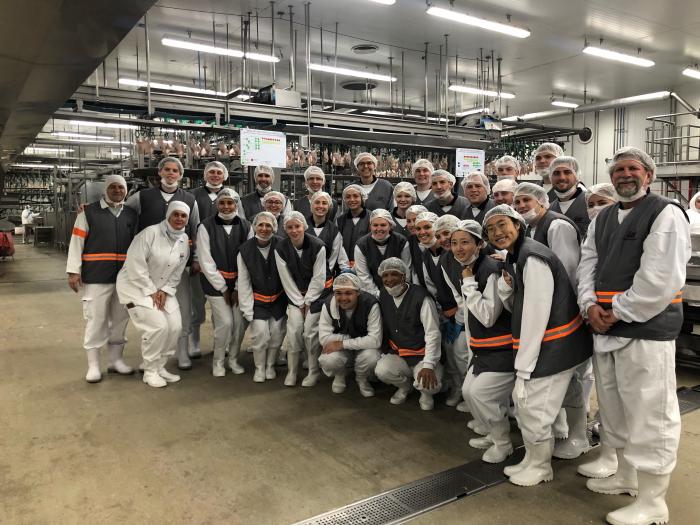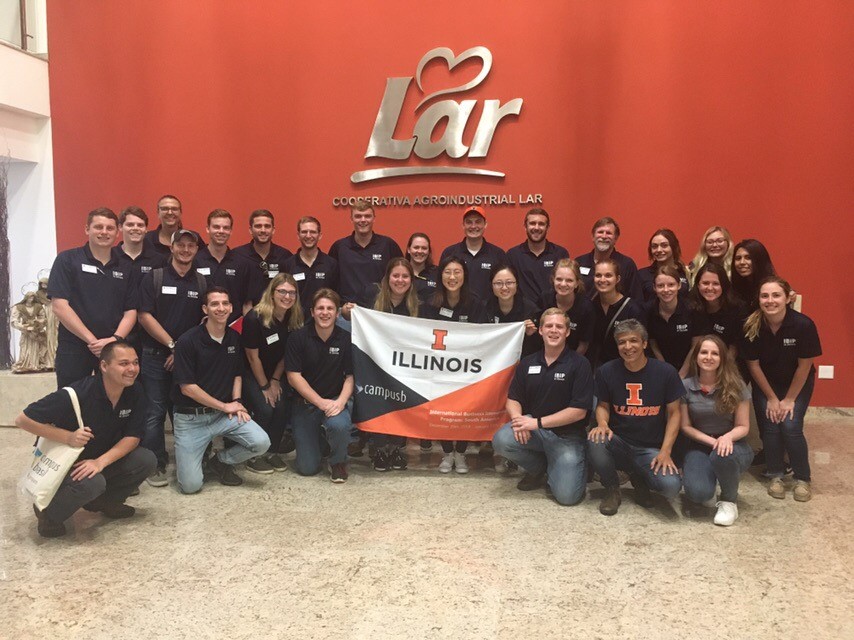From Farm to Grocery Store

The first Monday of the New Year was exciting for our group! We started the morning bright and early in Iguazu Falls and set out for our next destination in Matelandia. It was a very full day full of new experiences. We visited Lar Cooperative’s Poultry Center, had lunch in a castle themed restaurant, learned about Frimesa while sampling their yummy products, and ended with informational sessions at Lar’s Administrative Center.
In the morning, we visited the LAR Cooperative Poultry Center under the guidance of experienced technicians. It was very eye opening, and for most of the students, it was the first time seeing the production line of the poultry, from slaughtering, cooling, cutting to packaging. The poultry center can produce 12,000 chickens per hour and there are 110 trucks per day with 3,400 birds per truck to transport the poultry to the closest port. It was surprising to learn that 85% of the production would be used for export, to countries like Europe, China and Japan. Cutting units were separated for local supply and importers as they have different demands and rules for the poultry. For instance, they use lasers to cut chicken legs into exact 5g pieces for the Japanese exports. Every part of the chicken is put to good use. Even the non-edible parts like feathers and innards are processed into flour to feed livestock and pets. After the visit, we had gourmet Italian food at the Castelletto restaurant. Thank you to our hosts from the LAR cooperative!
The next stop was Frimesa Producer. Frimesa is a producer that works with five different producers to bring dairy, beef, and wine producers to the market. They deal with all the business aspects, and provide support to the consumers. They help bring over 450 products to the market. Many of these products can be seen around supermarkets and gas stations in Brazil. We even saw some of their dairy products at breakfast! Their most up and coming product is prepackaged season swine, and they send their products all over the world, mostly to Europe and East Asia. After learning about Primesca and what they do for the Brazilian market, we were able to taste test some of their products including cheese, meat, yogurt, and much more.
After we visited Frimesa, we traveled to the LAR Administrative Center. The LAR Agricultural Cooperative was created in 1964. According to a presentation at the LAR Administration Center in Medianera, a priest and farmers founded the co-op to help sell their agricultural products. The co-op also offers input purchasing, animal processing, and exportation of products. There are 10,886 cooperative members and 85% of these members are considered small owners, which consists of under 60 hectares. The LAR has physical agricultural locations in three Brazilian states. These states are Paraná, Mato Grosso do Sul, and Santa Catarina. Not only does LAR provide services to producers, they also have gas stations and supermarkets. They sell 88% of their products in five states at their supermarkets. The company also has a strong sense of social responsibility and sustainability. This has led them to be involved in research endeavors with universities, the public sector, and other companies. An example of this is a postharvest loss project with the University of Illinois at Urbana-Champaign’s Dr. Mary Arends-Kuenning and Western Paraná State University’s Dr. Pery Francisco Assis Shikida.
Our busy day concluded with a bus ride to our next destination: Toledo. We checked into our hotel then walked to the mall for dinner. We ordered everything from tilapia to salads, burgers to chicken parmigiana and everything turned out delicious. We are tired from our day, but still so excited about the adventures ahead the rest of the week!
